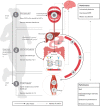Primary, Secondary, and Tertiary Effects of Carbohydrate Ingestion During Exercise
- PMID: 32936440
- PMCID: PMC8159838
- DOI: 10.1007/s40279-020-01343-3
Primary, Secondary, and Tertiary Effects of Carbohydrate Ingestion During Exercise
Erratum in
-
Correction to: Primary, Secondary, and Tertiary Effects of Carbohydrate Ingestion During Exercise.Sports Med. 2021 Dec;51(12):2671. doi: 10.1007/s40279-021-01489-8. Sports Med. 2021. PMID: 34043186 Free PMC article. No abstract available.
Abstract
The purpose of this current opinion paper is to describe the journey of ingested carbohydrate from 'mouth to mitochondria' culminating in energy production in skeletal muscles during exercise. This journey is conveniently described as primary, secondary, and tertiary events. The primary stage is detection of ingested carbohydrate by receptors in the oral cavity and on the tongue that activate reward and other centers in the brain leading to insulin secretion. After digestion, the secondary stage is the transport of monosaccharides from the small intestine into the systemic circulation. The passage of these monosaccharides is facilitated by the presence of various transport proteins. The intestinal mucosa has carbohydrate sensors that stimulate the release of two 'incretin' hormones (GIP and GLP-1) whose actions range from the secretion of insulin to appetite regulation. Most of the ingested carbohydrate is taken up by the liver resulting in a transient inhibition of hepatic glucose release in a dose-dependent manner. Nonetheless, the subsequent increased hepatic glucose (and lactate) output can increase exogenous carbohydrate oxidation rates by 40-50%. The recognition and successful distribution of carbohydrate to the brain and skeletal muscles to maintain carbohydrate oxidation as well as prevent hypoglycaemia underpins the mechanisms to improve exercise performance.
Conflict of interest statement
IR is an employee of the Gatorade Sports Science Institute, a division of PepsiCo, Incorporated. The views expressed in this article are those of the authors and do not necessarily reflect the position or policy of PepsiCo, Incorporated. LJCvL and CJF have received research grants, consulting fees, speaking honoraria, or a combination of these, from Kenniscentrum Suiker & Voeding and PepsiCo.
Figures



References
-
- Bergstrom J, et al. Diet, muscle glycogen and physical performance. Acta Physiol Scand. 1967;71(2):140–150. - PubMed
-
- Sherman WM, et al. Effect of exercise-diet manipulation on muscle glycogen and its subsequent utilization during performance. Int J Sports Med. 1981;2(2):114–118. - PubMed
-
- Brewer J, Williams C, Patton A. The influence of high carbohydrate diets on endurance running performance. Eur J Appl Physiol Occup Physiol. 1988;57(6):698–706. - PubMed
-
- Chryssanthopoulos C, et al. Skeletal muscle glycogen concentration and metabolic responses following a high glycaemic carbohydrate breakfast. J Sports Sci. 2004;22(11–12):1065–1071. - PubMed
MeSH terms
Substances
LinkOut - more resources
Full Text Sources
Medical

